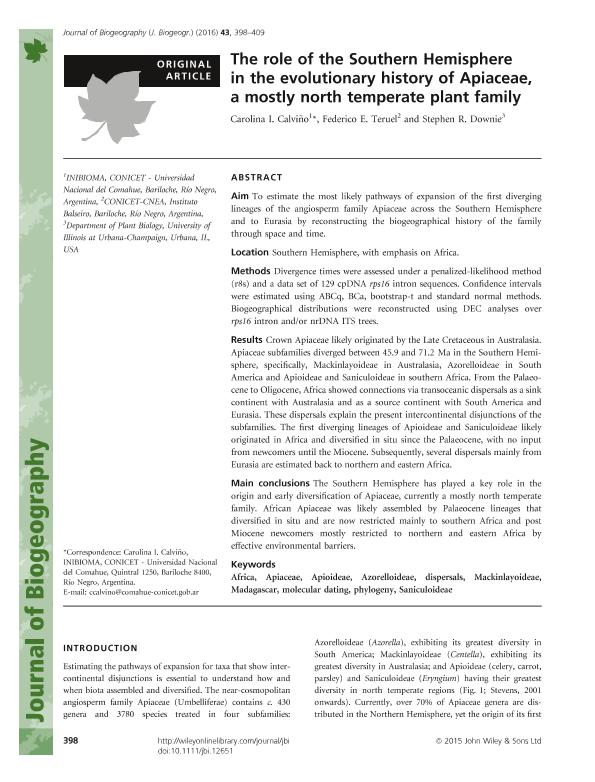Mostrar el registro sencillo del ítem
dc.contributor.author
Calviño, Carolina Isabel

dc.contributor.author
Teruel, Federico Eduardo

dc.contributor.author
Downie, Stephen R.
dc.date.available
2018-09-11T18:07:04Z
dc.date.issued
2016-02-16
dc.identifier.citation
Calviño, Carolina Isabel; Teruel, Federico Eduardo; Downie, Stephen R.; The role of the Southern Hemisphere in the evolutionary history of Apiaceae, a mostly north temperate plant family; Wiley Blackwell Publishing, Inc; Journal of Biogeography; 43; 2; 16-2-2016; 398-409
dc.identifier.issn
0305-0270
dc.identifier.uri
http://hdl.handle.net/11336/59127
dc.description.abstract
Aim: To estimate the most likely pathways of expansion of the first diverging lineages of the angiosperm family Apiaceae across the Southern Hemisphere and to Eurasia by reconstructing the biogeographical history of the family through space and time. Location: Southern Hemisphere, with emphasis on Africa. Methods: Divergence times were assessed under a penalized-likelihood method (r8s) and a data set of 129 cpDNA rps16 intron sequences. Confidence intervals were estimated using ABCq, BCa, bootstrap-t and standard normal methods. Biogeographical distributions were reconstructed using DEC analyses over rps16 intron and/or nrDNA ITS trees. Results: Crown Apiaceae likely originated by the Late Cretaceous in Australasia. Apiaceae subfamilies diverged between 45.9 and 71.2 Ma in the Southern Hemisphere, specifically, Mackinlayoideae in Australasia, Azorelloideae in South America and Apioideae and Saniculoideae in southern Africa. From the Palaeocene to Oligocene, Africa showed connections via transoceanic dispersals as a sink continent with Australasia and as a source continent with South America and Eurasia. These dispersals explain the present intercontinental disjunctions of the subfamilies. The first diverging lineages of Apioideae and Saniculoideae likely originated in Africa and diversified in situ since the Palaeocene, with no input from newcomers until the Miocene. Subsequently, several dispersals mainly from Eurasia are estimated back to northern and eastern Africa. Main conclusions: The Southern Hemisphere has played a key role in the origin and early diversification of Apiaceae, currently a mostly north temperate family. African Apiaceae was likely assembled by Palaeocene lineages that diversified in situ and are now restricted mainly to southern Africa and post Miocene newcomers mostly restricted to northern and eastern Africa by effective environmental barriers.
dc.format
application/pdf
dc.language.iso
eng
dc.publisher
Wiley Blackwell Publishing, Inc

dc.rights
info:eu-repo/semantics/openAccess
dc.rights.uri
https://creativecommons.org/licenses/by-nc-sa/2.5/ar/
dc.subject
Africa
dc.subject
Apiaceae
dc.subject
Apioideae
dc.subject
Azorelloideae
dc.subject
Dispersals
dc.subject
Mackinlayoideae
dc.subject
Madagascar
dc.subject
Molecular Dating
dc.subject
Phylogeny
dc.subject
Saniculoideae
dc.subject.classification
Otras Ciencias Biológicas

dc.subject.classification
Ciencias Biológicas

dc.subject.classification
CIENCIAS NATURALES Y EXACTAS

dc.title
The role of the Southern Hemisphere in the evolutionary history of Apiaceae, a mostly north temperate plant family
dc.type
info:eu-repo/semantics/article
dc.type
info:ar-repo/semantics/artículo
dc.type
info:eu-repo/semantics/publishedVersion
dc.date.updated
2018-08-27T14:01:37Z
dc.journal.volume
43
dc.journal.number
2
dc.journal.pagination
398-409
dc.journal.pais
Reino Unido

dc.journal.ciudad
Londres
dc.description.fil
Fil: Calviño, Carolina Isabel. Consejo Nacional de Investigaciones Científicas y Técnicas. Centro Científico Tecnológico Conicet - Patagonia Norte. Instituto de Investigaciones en Biodiversidad y Medioambiente. Universidad Nacional del Comahue. Centro Regional Universidad Bariloche. Instituto de Investigaciones en Biodiversidad y Medioambiente; Argentina
dc.description.fil
Fil: Teruel, Federico Eduardo. Consejo Nacional de Investigaciones Científicas y Técnicas. Centro Científico Tecnológico Conicet - Patagonia Norte; Argentina. Comisión Nacional de Energía Atómica. Gerencia del Área de Energía Nuclear. Instituto Balseiro; Argentina
dc.description.fil
Fil: Downie, Stephen R.. University of Illinois at Urbana; Estados Unidos
dc.journal.title
Journal of Biogeography

dc.relation.alternativeid
info:eu-repo/semantics/altIdentifier/url/https://onlinelibrary.wiley.com/doi/abs/10.1111/jbi.12651
dc.relation.alternativeid
info:eu-repo/semantics/altIdentifier/doi/http://dx.doi.org/10.1111/jbi.12651
Archivos asociados
